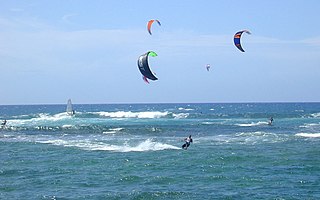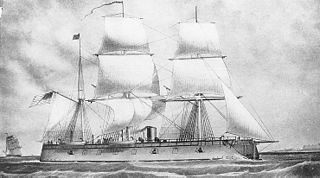
The Rogallo wing is a flexible type of wing. In 1948, Francis Rogallo, a NASA engineer, and his wife Gertrude Rogallo, invented a self-inflating flexible wing they called the Parawing, also known after them as the "Rogallo Wing" and flexible wing. NASA considered Rogallo's flexible wing as an alternative recovery system for the Mercury and Gemini space capsules, and for possible use in other spacecraft landings, but the idea was dropped from Gemini in 1964 in favor of conventional parachutes.

A power kite or traction kite is a large kite designed to provide significant pull to the user.

USS Galena was a wooden-hulled broadside ironclad built for the United States Navy during the American Civil War. The ship was initially assigned to the North Atlantic Blockading Squadron and supported Union forces during the Peninsula Campaign in 1862. She was damaged during the Battle of Drewry's Bluff because her armor was too thin to prevent Confederate shots from penetrating. Widely regarded as a failure, Galena was reconstructed without most of her armor in 1863 and transferred to the West Gulf Blockading Squadron in 1864. The ship participated in the Battle of Mobile Bay and the subsequent Siege of Fort Morgan in August. She was briefly transferred to the East Gulf Blockading Squadron in September before she was sent to Philadelphia, Pennsylvania for repairs in November.

A tape measure or measuring tape is a flexible ruler used to measure length or distance.
Kite types, kite mooring, and kite applications result in a variety of kite control systems. Contemporary manufacturers, kite athletes, kite pilots, scientists, and engineers are expanding the possibilities.

A hairbrush is a brush with rigid or light and soft spokes used in hair care for smoothing, styling, and detangling human hair, or for grooming an animal's fur. It can also be used for styling in combination with a curling iron or hair dryer.

DECtape, originally called Microtape, is a magnetic tape data storage medium used with many Digital Equipment Corporation computers, including the PDP-6, PDP-8, LINC-8, PDP-9, PDP-10, PDP-11, PDP-12, and the PDP-15. On DEC's 32-bit systems, VAX/VMS support for it was implemented but did not become an official part of the product lineup.

USS New Ironsides was a wooden-hulled broadside ironclad built for the United States Navy during the American Civil War. The ship spent most of her career blockading the Confederate ports of Charleston, South Carolina, and Wilmington, North Carolina, in 1863–65. New Ironsides bombarded the fortifications defending Charleston in 1863 during the First and Second Battles of Charleston Harbor. At the end of 1864 and the beginning of 1865 she bombarded the defenses of Wilmington in the First and Second Battles of Fort Fisher.

The kicksled or spark is a small sled consisting of a chair mounted on a pair of flexible metal runners that extend backward to about twice the chair's length. The sled is propelled by kicking the ground by foot. There is a handlebar attached to the top of the chair back. Kicksled is a direct translation of the Finnish word potkukelkka. Estonian calls it either a 'pushsled' or 'Finnish sled'. Some other possible translations are kicker and chair-sled.

Peter Lynn is a New Zealand kitemaker, engineer and inventor. He is notable for his construction of the world's largest kites, giant inflatable (sparless) display kites, the popularisation of kite buggying and contributions to the development of power kiting and kitesurfing. He spends much of the year travelling worldwide and displaying his kites at International Kite Festivals.

An Armstrong gun was a uniquely designed type of rifled breech-loading field and heavy gun designed by Sir William Armstrong and manufactured in England beginning in 1855 by the Elswick Ordnance Company and the Royal Arsenal at Woolwich. Such guns involved a built-up gun construction system of a wrought-iron tube surrounded by a number of wrought-iron strengthening coils shrunk over the inner tube to keep it under compression.
The sled kite was invented and patented by the American William Allison in the 1950s. This kite helped pave the way for a class of kites known as "semi-rigid."

The ram-air inflatable single-line kite is one of the few modern inventions in the world of kite design. Although Francis Rogallo's early kite patents had ram-air members in the claims, Domina Jalbert's parafoil ram-air wing, patented in 1944, emphatically changed the kite airscape for inflatable kites.
HMS Starfish was a Sturgeon-class destroyer which served with the Royal Navy. Built by Vickers, she was launched in 1895 and sold in 1912.

Domina Cleophas Jalbert (1904–1991) invented the ram-air inflated flexible wing, often called the "Jalbert parafoil".

Kites are tethered flying objects which fly by using aerodynamic lift, requiring wind for generation of airflow over the lifting surfaces.
The Comper Kite was a single-engined, two-seat touring monoplane built in the UK, derived from the contemporary Comper Streak racer. Only one was built.

The United States provided many inventions in the time from the Colonial Period to the Gilded Age, which were achieved by inventors who were either native-born or naturalized citizens of the United States. Copyright protection secures a person's right to his or her first-to-invent claim of the original invention in question, highlighted in Article I, Section 8, Clause 8 of the United States Constitution, which gives the following enumerated power to the United States Congress:
To promote the Progress of Science and useful Arts, by securing for limited Times to Authors and Inventors the exclusive Right to their respective Writings and Discoveries.

Flexible Flyer is a toy and recreational equipment brand, best known for the sled of the same name, a steerable wooden sled with steel runners.
Diamond Reef System, including each individual Hover Station and the new Multi-Portal System, are trademarked, skill evaluation and safety-based diving curriculums that utilize the world's first portable, collapsible underwater obstacle course to simulate fragile reef or dive wreck structure for diver buoyancy skill and underwater photography training. A form of scuba Gymkhana, the program was designed by Pete Wallingford in 1988 to educate scuba instructors and scuba divers on how to safely teach and promote situational awareness, proper body positioning and safe interaction with coral reefs, fragile marine ecosystems and shipwrecks. The program was adopted by the Environmental Protection Agency, the National Oceanic and Atmospheric Administration, dive store operators and dive resort/charter operators worldwide.

















